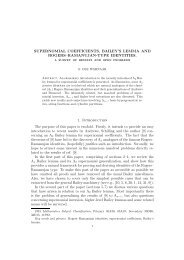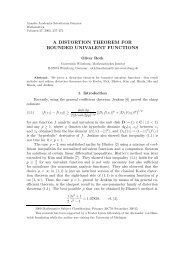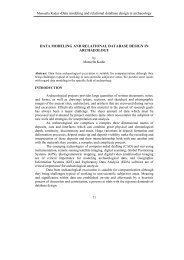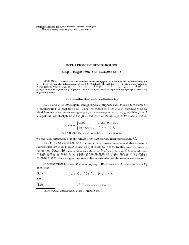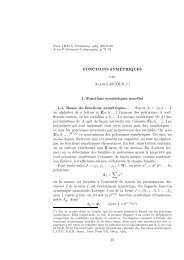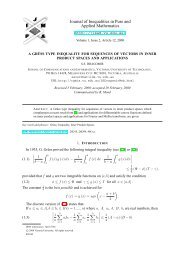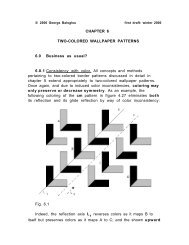THE COMBINATORICS OF THE AL-SALAM-CHIHARA q ...
THE COMBINATORICS OF THE AL-SALAM-CHIHARA q ...
THE COMBINATORICS OF THE AL-SALAM-CHIHARA q ...
You also want an ePaper? Increase the reach of your titles
YUMPU automatically turns print PDFs into web optimized ePapers that Google loves.
Séminaire Lotharingien de Combinatoire 54 (2006), Article B54i<strong>THE</strong> <strong>COMBINATORICS</strong> <strong>OF</strong> <strong>THE</strong> <strong>AL</strong>-S<strong>AL</strong>AM-<strong>CHIHARA</strong> q-CHARLIERPOLYNOMI<strong>AL</strong>SDONGSU KIM, DENNIS STANTON, AND JIANG ZENGDedicated to Xavier Viennot on the occasion of his sixtieth birthdayAbstract. We describe various aspects of the Al-Salam-Chihara q-Charlier polynomials.These include combinatorial descriptions of the polynomials, the moments, theorthogonality relation and a combinatorial proof of Anshelevich’s recent result on thelinearization coefficients.1. IntroductionThe classical Charlier polynomials Cn(x) a have been studied combinatorially by severalauthors [5, 8, 14]. Recall [4] that these polynomials are defined byn∑( nCn(x) a = (−a)k)n−k x(x − 1) · · · (x − (k − 1)) (1.1)k=0and satisfy the three term-recurrence relationC a n+1(x) = (x − a − n) C a n(x) − an C a n−1(x), n ≥ 0, (1.2)where C a 0 (x) = 1, C a −1(x) = 0.A q-version C a n(x; q) of these polynomials was studied in [6]. The three-term recurrencerelation wasC a n+1(x; q) = (x − aq n − [n] q ) C a n(x; q) − aq n−1 [n] q C a n−1(x; q),where [n] q = 1+q+· · ·+q n−1 , C0 a (x; q) = 1, C−1(x; a q) = 0. The explicit formula analogousto (1.1) is given byn∑[nCn(x; a q) = (−a)k]n−k q (n−k 2 ) k−1 ∏(x − [i] q ).qk=0The linearization coefficients for the Charlier polynomials are given by quotients offactorials (see (1.5)). The combinatorial study of the q-analogues C a n(x; q) in [6] includedfinding their linearization coefficients, which were given by a double sum, not quotientsof factorials, and as a polynomial in q and a did not have positive coefficients (see [6,Theorem 3]).The first author was partially supported by KRF grant R05-2004-000-11511-0.The second author was partially supported by NSF grant DMS-0503660.i=0
2 DONGSU KIM, DENNIS STANTON, AND JIANG ZENGAnshelevich [2] has recently considered a q-analogue of the three-term recurrence (1.2)for Cn(x a + a, a) and proved that the linearization coefficients of the corresponding polynomialsare polynomials of a and q with positive integer coefficients (see Theorem 6).The aim of this paper is to study the combinatorial aspects of a new q-analogue ofCharlier polynomials, which is a re-scaled version of Anshelevich’s q-polynomials and turnsout to be a special re-scaled version of the Al-Salam-Chihara polynomials. We shall givea combinatorial proof of Anshelevich’s result by using the combinatorial interpretationsof the polynomials and their moments. It is inspired by the beautiful proofs for otherclassical orthogonal polynomials in [7, 10].This paper is organized as follows: in the next two sections we give the definitionsand combinatorial interpretations of the new q-Charlier polynomials and their moments,Corollary 3 and Theorem 4. The explicit linearization coefficients are given in §4 inCorollary 8. We then give the killing involution in §5. We present a variation Ĉn(x|q)of the polynomials C n (x, a; q) in §6, which has the advantage to include the q-Hermitepolynomials in [10] as a special case.We collect here some well-known facts about Charlier polynomials.The generating function is∞∑Cn(x) a tnn! = e−at (1 + at) x . (1.3)n=0The moment sequence µ n is given by the following formula:∞∑µ n = L(x n ) = x n −a axn∑ex! = S(n, k)a k , (1.4)x=0where S(n, k) denotes the Stirling number of the second kind. The orthogonality reads:∞∑L(Cm(x)C a n(x)) a = Cm(k)C a n(k) a e−a a k= n!a n δ mn .k!The linearization coefficient c n 3n 1 n 2k=0is defined by:k=1C a n 1(x)C a n 2(x) = ∑ n 3c n 3n 1 n 2C a n 3(x).By orthogonality we have c n 3n 1 n 2= L(Cn a 1(x)Cn a 2(x)Cn a 3(x))/L(Cn a 3(x)Cn a 3(x)).For Charlier polynomials it is easy to derive from (1.3) and (1.4) that∞∑L(Cn a 1(x) . . . Cn a k(x)) tn 11n 1 ! . . . tn kkn k ! = ea(e 2(t 1 ,...,t k )+...+e k (t 1 ,...,t k )) ,n 1 ,...,n k =0where e i is the elementary symmetric function of degree i. It follows thatL(C a n 1(x)C a n 2(x)C a n 3(x)) = ∑ ln 1 !n 2 !n 3 !a l+n 3l!(n 3 − n 1 + l)!(n 3 − n 2 + l)!(n 1 + n 2 − n 3 − 2l)! . (1.5)
<strong>THE</strong> <strong>COMBINATORICS</strong> <strong>OF</strong> <strong>THE</strong> <strong>AL</strong>-S<strong>AL</strong>AM-<strong>CHIHARA</strong> q-CHARLIER POLYNOMI<strong>AL</strong>S 3In the general case the above generating function implies that L(C a n 1(x) . . . C a n k(x)) (k ≥ 1)is a polynomial in a with positive integer coefficients; a combinatorial interpretation ofthis coefficient has been given [8, 14].2. The new q-Charlier polynomialsWe define the new q-Charlier polynomials C n (x, a; q) byC n+1 (x, a; q) = (x − a − [n] q ) C n (x, a; q) − a[n] q C n−1 (x, a; q). (2.1)The first values of these polynomials areC 1 (x, a; q) = x − a,C 2 (x, a; q) = x 2 − (2 a + 1)x + a 2 ,C 3 (x, a; q) = x 3 − (q + 3 a + 2)x 2 + (aq + 3 a 2 + 2 a + q + 1)x − a 3 .The explicit formula which is analogous to (1.1) isn∑[ k−1n ∏ (C n (x, a; q) = qk]k(k−n) (−a) n−k x − [i]q + a(q −i − 1) ) . (2.2)k=0qThis is a re-scaled version of the Al-Salam-Chihara polynomials Q n (x, α, β; q) [12, p.80–81]:( ) (n/2√ (a1 1 − qC n (x, a; q) =Q n x − a − 1 ))−1, √ , 0; q .1 − q 2 a1 − q a(1 − q)Since the generating function of the Al-Salam-Chihara polynomials is known, we derivethat∞∑C n (x, a; q) tn(−t; q) ∞=n! q ( √ a(1 − q)te iθ , √ ,a(1 − q)te −iθ ; q) ∞n=0where n! q = [n] q [n − 1] q . . . [2] q [1] q andcos θ = 1 √1 − q2 ai=0(x − a − 1 ).1 − qWe can give a combinatorial interpretation for the q-Charlier polynomials from a resultdue to Simion and Stanton [13].Consider a subset B of [n] and a permutation σ on [n] \ B. Then σ consists of fixedpoints and cycles of length > 1:C = (k 0 , k 1 , k 2 , . . . , k s ), where k s > max{k 0 , k 1 , · · · k s−1 }.For any k ∈ [n] \ B, let w(k) = 0 if k is the maximum of its cycle, otherwise k = k j is ona cycle C as above, then∑w(k) = k − 1 − |{i : j < i < s, k i < k j }| −(# of points on Q less than k).cycles Q, max(Q)>k s
4 DONGSU KIM, DENNIS STANTON, AND JIANG ZENGLet w(B, σ) = ∑ k∈[n]\Bw(k) and let cyc(σ) be the number of cycles of σ.Example 1. Let n = 9, B = {2, 9} and σ = (6)(4 7)(3 5 1 8) (in cycle notation withmaximum at last). Then we have cyc(σ) = 3 andTheorem 1. We havew(B, σ) = (3 − 1 − 1) + (5 − 1 − 1) + (1 − 1) + (4 − 1 − 2) = 5.C n (x, a; q) = ∑(−1) n−cyc(σ) a |B| x cyc(σ) q w(B,σ) .(B,σ)where B ⊂ [n] and σ is a permutation on [n] \ B.Proof. This is the r = 1, s = 0, t = q, u = 1 special case of the quadrabasic Laguerrepolynomials [13, p.313].□We now assume that each permutation π of [n] is represented as a product of disjointcycles, π = σ 1 σ 2 · · · σ k , where the cycles are written in the descending order of theirmaxima and each σ i has its maximum at the first position. A pair (i, j), i > j, is called aCharlier-inversion in π = σ 1 σ 2 · · · σ k if i is not a maxima of any cycles of π and i appearsto the left of j in π. For instance, (6, 2), (6, 4), (6, 5), (6, 1), (6, 3), (2, 1), (4, 1) and (4, 3)are all Charlier-inversions in π = (8 6 2)(7 4)(5 1 3). Let Cinv(π) denote the number ofCharlier-inversions in π.Definition 2. (Charlier-labeling of permutations) A Charlier-labeling of a permutationπ = σ 1 σ 2 · · · σ k is a labeling of integers and cycles in π satisfying the following rules:• Each integer in π is labeled −1.• Each cycle of length 1 is labeled either −x or a.• Each cycle of length > 1 is labeled −x.A permutation with a Charlier-labeling is called a Charlier-permutation.Let τ denote a Charlier-permutation with underlying permutation π. Identify Cinv(τ)with Cinv(π). Define the weight of τ, w(τ), to be the product of q Cinv(τ) and all thelabels of integers and of cycles in τ. Since only 1-cycles are allowed two different choicesfor a label, if π has f fixed points, there are 2 f distinct Charlier-permutations with πas an underlying permutation. We represent each cycle in a permutation as a sequencestarting with the maximum, enclosed with a pair of parentheses. The cycles in a Charlierpermutationare represented in the same way except that 1-cycles with label a are enclosedwith a pair of brackets.For each pair (B, σ) in Theorem 1, where B ⊂ [n] and σ a permutation of [n] \ B,one can associate a Charlier-permutation τ of [n] as follows: each element of B gives risea 1-cycle with brackets, each cycle (a 1 a 2 . . . a l ) of σ gives rise a cycle (a l a l−1 . . . a 1 ) of τwith reverse order and the maximal element at the first position. It is not hard to seethat w(B, σ) = Cinv(τ). For instance, the Charlier-permutation corresponding to thepair (B, σ) in the above example is τ = [9](8 1 5 3)(7 4)(6)[2] with weight(−1) 9 (−x) 3 a 2 q 0+3+1+1 = a 2 q 5 x 3 ,
<strong>THE</strong> <strong>COMBINATORICS</strong> <strong>OF</strong> <strong>THE</strong> <strong>AL</strong>-S<strong>AL</strong>AM-<strong>CHIHARA</strong> q-CHARLIER POLYNOMI<strong>AL</strong>S 5because there are nine integers of label −1, three cycles of label −x, two cycles of labela, five Charlier-inversions, i.e. (5, 3), (5, 4), (5, 2), (3, 2), (4, 2).One can restate Theorem 1 as follows.Corollary 3. The q-Charlier polynomial C n (x, a; q) is the generating function of Charlierpermutationsof [n]:C n (x, a; q) = ∑ τwhere τ runs through all permutations of [n].w(τ),3. The momentsFor the Charlier polynomials Cn(x), a the n th moment µ n is the generating function forset partitions of {1, 2, · · · , n} according to the number of blocks (see (1.4)). There is anatural q-analogue for the polynomials Cn(x; a q) [6, Eq. (3.1)], whose n th moment isn∑µ n = S q (n, k)a k .k=1Note that S q (n, k) is the most natural q-analogue of the Stirling numbers of the secondkind, and may also be interpreted as a generating function for set partitions with k blocksaccording to a q-statistic. It has a remarkably simple expression as a single sum [6, Eq.(3.3)]. In this section we identify an appropriate q-statistic on set partitions which yieldsthe n th moment µ n for C n (x, a; q), and give an explicit formula for it.Recall that if π is a partition of M = {1, . . . , m}, then a crossing of π is a quadruple(a, b, c, d) of elements of M such that a < b < c < d, the elements a, c are in someblock of the partition and b, d are in another block. For two elements e and f of M,with e < f, we say that f follows e in π if e and f belong to the same block of π, andthere is no element g of this block with e < g < f. We define a restricted crossing tobe a crossing (a, b, c, d) such that c follows a and d follows b. Similarly a nesting is aquadruple (a, b, c, d) of elements of M such that a < b < c < d, the elements a, d are insome block of the partition and b, c are in another block. We define a restricted nestingto be a nesting (a, b, c, d) such that d follows a and c follows b. The restricted crossingsand nestings have a natural interpretation in the graphic line representation of partitions.This representation consists in drawing the m points on the x-axis in the plane and, if ffollows e, joining the point e and f by an arc above the x-axis.For instance, the graph of π = {1, 6, 10} − {2, 3, 9} − {4, 7} − {5, 8} is the following:123456Let rc(π) (resp. rn(π)) be the number of restricted crossings (resp. restricted nestings)of a partition π. The number of blocks of π is denoted by block(π). For the above π78910
6 DONGSU KIM, DENNIS STANTON, AND JIANG ZENGwe have block(π) = 4, rc(π) = 7 and there are rn(π) = 3 restricted nestings, namely(1, 2, 3, 6), (3, 4, 7, 9), (3, 5, 8, 9).We can derive the combinatorial interpretation of the moments from the continuedfraction expansion of the ordinary generating functions of partitions with respect to thecorresponding statistics (see [3, 11]) and the three-term recurrence relation (2.1).Theorem 4. The n th -moment of the q-Charlier polynomials C n (x, a; q) isµ n (a) := L q (x n ) = ∑a block(π) q rc(π) = ∑a block(π) q rn(π) ,π∈Π n π∈Π nwhere Π n denotes the set of partitions of [n] := {1, . . . , n}.The first values of µ n (a) are as follows:µ 1 (a) = a, µ 2 (a) = a+a 2 , µ 3 (a) = a+3a+a 3 , µ 4 (a) = a+(6+q)a 2 +6a 3 +a 4 .It is possible to derive an explicit formula for the moments from the known measure forthe Al-Salam-Chihara polynomials and facts about q-Hermite polynomials. We do notgive the details of this calculation.Let θ 0 = 1, and for odd values of m ≥ 1 letθ m =k=0⌊m/2⌋∑k=0( ) ⌊m/2⌋−km ∑kl=0l=0[(−1) m−l (a(1 − q)) k+l(2 √ 1 − q m−2k m − 2k − la(1 − q)) m 1 − q m−2k−l l]q (l 2) ,qwhile for even values of m ≥ 1 let⌊m/2⌋−1∑( ) ⌊m/2⌋−km ∑[ ] ( )(−1) m−l (a(1 − q)) k+lθ m =k (2 √ 1 − q m−2k m − 2k − lqa(1 − q)) m 1 − q m−2k−l l(l 2) 1 m + .q2 m m/2Proposition 5. The n th -moment of the q-Charlier polynomials C n (x, a; q) is given byn∑( nµ n (a) = um)−n (−v) n−m θ m ,whereu = 1 2√1 − qam=0a(1 − q) + 1and v = −2 √ a(1 − q) .4. The orthogonality relation and the linearization of productsThe orthogonality of the q-Charlier polynomials reads as follows:L q (C n (x, a; q)C m (x, a; q)) = n! q a n δ mn .In this section we state Anshelevich’s linearization result, which generalizes the orthogonalityrelation, in Theorem 6, and explicitly evaluate the coefficients in Corollary 8.Set n = n 1 + n 2 + · · · n k . Denote byπ n1 ,n 2 ,...,n k∈ Π n
<strong>THE</strong> <strong>COMBINATORICS</strong> <strong>OF</strong> <strong>THE</strong> <strong>AL</strong>-S<strong>AL</strong>AM-<strong>CHIHARA</strong> q-CHARLIER POLYNOMI<strong>AL</strong>S 7the partition whose blocks are intervals of consecutive integers of lengths n 1 , n 2 , . . . , n k .DenoteΠ(n 1 , n 2 , . . . , n k ) = {π ∈ Π n : π has no singleton and π ∧ π n1 ,n 2 ,...,n k= ˆ0},the partitions without singleton and inhomogeneous with respect to π n1 ,n 2 ,...,n k, that is,the collection of all partitions which do not put together elements of the k distinguishedsubsets in the same block. Thus π = {1, 6, 10} − {2, 3, 9} − {4, 7} − {5, 8} ∈ Π(2, 4, 4).In 2005 Anshelevich [2] considered the re-scaled version C n (x + a, a; q) and proved thefollowingTheorem 6 (Anshelevich). The linearization coefficients of q-Charlier polynomials arethe generating functions of the inhomogeneous partitions:∑L q (C n1 (x, a; q) · · · C nk (x, a; q)) =q rc(π) a block(π) . (4.1)π∈Π(n 1 ,n 2 ,...,n k )For example, if k = 3 and n 1 = n 2 = 2 and n 3 = 1, thenΠ(2, 2, 1) = {{(1, 3, 5)(2, 4)}, {(1, 4, 5)(2, 3)}, {(2, 3, 5)(1, 4)}, {(2, 4, 5)(1, 3)}}.It is easy to see that the corresponding generating function in (4.1) isa 2 q 2 + a 2 + a 2 q + a 2 q = a 2 (1 + q) 2 .If k = 2, equation (4.1) gives the orthogonality relation. When k = 3, there is an explicitformula for the generating function in (4.1).Theorem 7. We have∑π∈Π(n 1 ,n 2 ,n 3 )q rc(π) t block(π) = ∑ l≥0n 1 ! q n 2 ! q n 3 ! q t l+n 3q (n 1 +n 2 −n 3 −2l2 )l! q (n 3 − n 1 + l)! q (n 3 − n 2 + l)! q (n 1 + n 2 − n 3 − 2l)! q.Proof. First we verify the q = 1 case, and then give an argument for the q case.Let N 1 = [n 1 ], N 2 = [n 1 + n 2 ] \ [n 1 ] and N 3 = [n 1 + n 2 + n 3 ] \ [n 1 + n 2 ]. The type of asubset S of [n 1 + n 2 + n 3 ] is defined to be the triple (|S ∩ N 1 |, |S ∩ N 2 |, |S ∩ N 3 |).Consider the inhomogeneous partitions of the colored set [n 1 +n 2 +n 3 ] without singleton.Let a, b, c and d be respectively the numbers of blocks of type : A = (1, 1, 1), B = (1, 1, 0),C = (1, 0, 1) and D = (0, 1, 1). Thena + b + c = n 1 , a + b + d = n 2 , a + c + d = n 3 .Solving the equations and setting b = l we geta = n 1 + n 2 − n 3 − 2l, c = n 3 − n 2 + l, d = n 3 − n 1 + l.The total number of blocks is equal to a + b + c + d = n 3 + l, the power of t in Theorem 7.Given an inhomogeneous partition π with a blocks of type A, b blocks of type B, cblocks of type C, and d blocks of type D, the types of elements of [n 1 ] form a multisetpermutation w 1 of A a B b C c . Similarly we may define words w 2 and w 3 of lengths n 2 and n 3as multiset permutations of A a B b D d and A a C c D d . The number of such words (w 1 , w 2 , w 3 )
8 DONGSU KIM, DENNIS STANTON, AND JIANG ZENGis given by a product of three trinomial coefficients. The number of ways to choose edgesto connect like types of letters is a factorial, so there is a total of( )( )( )n1 n2 n3(a!) 2 b!c!d!a, b, c a, b, d a, c, dn 1 !n 2 !n 3 !=l!(n 3 − n 1 + l)!(n 3 − n 2 + l)!(n 1 + n 2 − n 3 − 2l)! ,inhomogeneous partitions.We include q in the above argument by keeping track of the possible restricted crossingsof π.If π has words (w 1 , w 2 , w 3 ), then some crossings are guaranteed from the w i , independentof how the edges are attached to the letters.• any occurrence in w 1 of B preceding C or A preceding C gives a crossing,• any occurrence in w 2 of D preceding B, D preceding A, or A preceding B gives acrossing,• any occurrence in w 3 of C preceding A or C preceding D gives a crossing.The remaining crossings are• crossings of edges of types ABAB and BABA, where the first two letters are inw 1 and the last two letters are in w 2 ,• crossings of edges of types ADAD and DADA, where the first two letters are inw 1 and the last two letters are in w 3 ,• crossings amongst edges of the same type.Construct π in the following manner. Fix a word w 2 , the guaranteed crossings in w 2 areexactly the inversions in w 2 if the letters are ordered BAD, thus the crossing generatingfunction for w 2 is [1, p. 41][ ]n2.a, b, dqChoose c of the positions in [n 1 ] for the locations of C in w 1 , the C-inversions in w 1give the crossing generating function[ ]n1.cqAlso choose the c positions in w 3 for C, the C-inversions in w 3 contribute[ ]n3cMatch these 2c positions with c inhomogeneous edges, the crossing generating function isc! q ..q
<strong>THE</strong> <strong>COMBINATORICS</strong> <strong>OF</strong> <strong>THE</strong> <strong>AL</strong>-S<strong>AL</strong>AM-<strong>CHIHARA</strong> q-CHARLIER POLYNOMI<strong>AL</strong>S 9Connect the a + b letters of w 2 of type A or B to the remaining a + b positions of w 1in (a + b)! ways. The crossings here have type ABAB, BABA, and the same type AA,BB. The generating function is(a + b)! q .Connect the a + d letters of w 2 of type A or D to the remaining a + d positions of w 3in (a + d)! ways. The crossings here have type ADAD, DADA, and the same type AA,DD. The generating function is(a + b)! q .Any pair of edges, each of type A, always has one remaining crossing which is notaccounted for, this isq (a 2) .Multiplying the above corresponding generating functions yields the formula.Corollary 8. We have the following linearization formula:C n1 (x, a; q)C n2 (x, a; q) = ∑ n 3K n1 n 2 n 3C n3 (x, a; q), (4.2)□whereK n1 n 2 n 3= ∑ l≥0n 1 ! q n 2 ! q a l q (n 1 +n 2 −n 3 −2l2 )l! q (n 3 − n 1 + l)! q (n 3 − n 2 + l)! q (n 1 + n 2 − n 3 − 2l)! q.Corollary 8 may also be proven using the Askey-Wilson integral, see [9, p. 422].5. A Combinatorial Proof of Theorem 6In this section we prove Theorem 6, using the combinatorial interpretation of the polynomialsgiven in Corollary 3 and the moments given in Theorem 4.5.1. Generalized Charlier-permutations. We fix n = (n 1 , . . . , n k ), where n i ’s arepositive integers. Let n denote n 1 + n 2 + · · · + n k . For 1 ≤ i ≤ k, let N i denote the set ofall integers j such that n 1 +· · ·+n i−1 < j ≤ n 1 +· · ·+n i , n 0 = 0. Then [n] = N 1 ∪· · ·∪N k .A generalized Charlier-permutation τ of type n is a sequence (τ k , τ k−1 , . . . , τ 1 ) where τ i isa Charlier-permutation of N i . The weight of a generalized Charlier-permutation is theproduct of the weights of its Charlier-permutations.The following are examples of generalized Charlier-permutations of type n = (2, 4, 3):(9 7)(8) | (6 5)(4 3) | (2)(1), (9 7)(8) | (6 5)(4 3) | [2](1), (9 7)(8) | (6 4)(5 3) | (2 1),(9 7)[8] | (6 4)(5 3) | (2 1), (9 8)[7] | (6 4)(5 3) | (2 1), (9 8)[7] | (6)(5 4)(3) | (2 1).
10 DONGSU KIM, DENNIS STANTON, AND JIANG ZENG5.2. Charlier-partitions. Combining generalized Charlier-permutations and momentsdiscussed in the previous sections, we want to interpretL q (C n1 (x, a; q) . . . C nk (x, a; q))as the weight generating function of some objects. The weight of any generalized Charlierpermutationcan be regarded as a monomial in x of degree the number of cycles labeled −x.Applying L q to the monomial is equivalent to considering all possible partitions of suchcycles, where cycles are ordered as they appear in the generalized Charlier-permutation.We call the resulting objects Charlier-partitions of n. A Charlier-partition is representedas (τ, ν), where τ = (τ k , τ k−1 , . . . , τ 1 ) is a generalized Charlier-permutation and ν is apartition of cycles labeled −x in τ. We regard each 1-cycle with label a as a block byitself in ν. The weight of (τ, ν) is defined byThen clearly we have the following identity:w(τ, ν) = q rc(ν) a block(ν) w(τ)| x=1.L q (C n1 (x, a; q) · · · C nk (x, a; q)) = ∑ (τ,ν)w(τ, ν). (5.1)Given a Charlier-partition (τ, ν) of n with τ = (τ k , τ k−1 , . . . , τ 1 ), we draw the correspondingdiagram on the plane as follows:• The n integers in τ are arranged on the horizontal axis in the order they appearin τ, one step apart.• The 1-cycles with label a are framed with a box.• The maximum in each cycle, except that in a box, is circled, so that we can recoverthe cycle structure and labels.• If a cycle σ follows a cycle σ ′ in a block of ν, then we draw an arc above thehorizontal line between the last element of σ ′ and the first element, that is alsothe maximum of σ, making as few crossings as possible. The smallest number ofcrossings agrees with the restricted crossings in ν, rc(ν).• Draw a straight edge between two adjacent elements if and only if they are in thesame cycle.Example 2. Let n = (3, 5, 5). Then (τ, ν) is a Charlier-partition of n, whereτ = ((13 11)(12 9)(10), (8 4 6)[7](5), (3 1)(2))is a generalized Charlier-permutation of type n andν = {{(13 11), (8 4 6), (3 1)}, {(12 9), (5), (2)}, {(10)}}is a partition of cycles of τ with weight −x. The corresponding diagram can be illustratedas follows: 13 11 12 9 10 8 4 6 7 5 3 1 2
<strong>THE</strong> <strong>COMBINATORICS</strong> <strong>OF</strong> <strong>THE</strong> <strong>AL</strong>-S<strong>AL</strong>AM-<strong>CHIHARA</strong> q-CHARLIER POLYNOMI<strong>AL</strong>S 115.3. Involution. The weight function in Equation (5.1) has many cancelations. Wewill give a combinatorial weight-preserving sign-reversing involution φ with fixed setΠ(n 1 , n 2 , . . . , n k ) defined on the set of all Charlier-partitions of type n.Let (τ, ν) be a Charlier-partition of n. The involution φ will be defined depending onthree different cases of (τ, ν).Case 1. If (τ, ν) has a circled 1-cycle in a block by itself or a boxed 1-cycle, thendefine φ(τ, ν) by picking up the smallest 1-cycle and switching its box to circle or viceversa. Since a boxed 1-cycle contributes −a and a circled 1-cycle a, φ is weight-preservingsign-reversing in this case.Case 2. We now assume that (τ, ν) has no 1-cycles, boxed or circled in a block by itself.Find the rightmost integer α, if it exists, in τ, say in τ i , such that it has a neighbor β inτ i , along the straight edge or an arc, to its right.Case 2.1. Assume that α and β are in the same cycle σ ending with α β, i.e. σ = (· · · α β).Since α is the penultimate entry in σ, β is not the maximum in σ. Suppose the contributionof β to Cinv(τ i ) is j. Then τ i is of the formτ i = (· · · ) · · · (· · · α β)(t m )(t m−1 ) · · · (t j+2 )(t j ) · · · (t 1 )with t 1 < t 2 < · · · < t m and t j+1 = β. Let τ ′ i = (· · · ) · · · (· · · α)(t m )(t m−1 ) · · · (t 1 ). Integerst m , t m−1 , . . . , t j+2 are moved to the left by one step and β occupies the position of t j+2 .We make some changes on the diagram of (τ, ν) as follows, to obtain the diagram of theCharlier-partition (τ ′ , ν ′ ):Algorithm: Stretch• Initially, start with the diagram of (τ, ν) with all arcs and edges.• Delete the straight edge between α and β in the diagram.• Rearrange t m , t m−1 , . . . , t 1 in descending order, leaving the arcs and edges intactin their present positions.• For l from m − 1 down to m − j, make the arc arriving from left at the positionof t l to arrive at t l+1 , if it exists; if there is no such arc at position t l and thereare no arcs at position t l+1 , then make the arc arriving from right at position t l toarrive at position t l+1 .• Add an arc between α and t m−j .Let φ(τ, ν) = (τ ′ , ν ′ ). We need to show that φ is a weight-preserving sign-reversinginvolution. The involution part will be clear after the next subcase is introduced. Clearlywe have w(τ ′ , ν ′ ) = −w(τ, ν) when q = 1, since (τ ′ , ν ′ ) has one more 1-cycle than (τ, ν),contributing −1 to w(τ ′ , ν ′ ). So it suffices to prove that the exponents of q in w(τ, ν) andw(τ ′ , ν ′ ) are the same. This can be done easily by induction on j. The loss in Charlierinversions from τ to τ ′ exactly matches the gain in restricted crossings from ν to ν ′ forall j.The following are some examples with n = (3, 6, 2).
12 DONGSU KIM, DENNIS STANTON, AND JIANG ZENG 11 10 9 81 207 6 5 4 3 2 1 11 10 9 81 20 7 6 5 4 3 2 1 11 10 9 81207 6 53 4 3 2 1 11 10 9 813 0 7 6 2 5 4 3 2 1 11 10 9 81207 6 53 4 3 2 1 11 10 9 81 7 6 2 3 50 4 3 2 1Three sets of (τ, ν) and (τ ′ , ν ′ ) of type n = (3, 6, 2) with α = 8.Case 2.2. We now assume that α and β are in different cycles. Clearly β forms a 1-cycleand adjoins α by an arc. Moreover, all integers to the right of α in τ i form 1-cycles andare in descending order. Suppose there are exactly j integers between α and β. Then τ i isof the form τ i = (· · · ) · · · (· · · α)(t m )(t m−1 ) · · · (t 1 ) with t 1 < t 2 < · · · < t m and t m−j = β.Let τ ′ i = (· · · ) · · · (· · · α t j+1 )(t m )(t m−1 ) · · · (t j+2 )(t j ) · · · (t 1 ). Integers t m , t m−1 , . . . , t j+2 aremoved to the right by one step and t j+1 occupies the position of t m . We make some changeson the diagram of (τ, ν) as follows, to obtain the diagram of the Charlier-partition (τ ′ , ν ′ ):Algorithm: Compress• Initially, start with the diagram of (τ, ν) with all arcs and edges.• Delete the arc between α and β = t m−j in the diagram.• For l from m − j to m − 1, make the arc arriving from left at the position of t l+1to arrive at t l , if it exists; if there is no such arc at position t l+1 and there are noarcs at position t l , then make the arc arriving from right at position t l+1 to arriveat position t l .• Rearrange t m , t m−1 , . . . , t j+1 as t j+1 , t m , t m−1 , . . . , t j+2 .
<strong>THE</strong> <strong>COMBINATORICS</strong> <strong>OF</strong> <strong>THE</strong> <strong>AL</strong>-S<strong>AL</strong>AM-<strong>CHIHARA</strong> q-CHARLIER POLYNOMI<strong>AL</strong>S 13• Add a straight edge between α and t j+1 .We let φ(τ, ν) = (τ ′ , ν ′ ).If (τ, ν) falls on Case 2.1 then (τ ′ , ν ′ ) falls on Case 2.2 and vice versa. The algorithmsStretch and Compress are inverses to each other. If the roles of (τ, ν) and (τ ′ , ν ′ ) areexchanged in the examples for algorithm Stretch, then they become examples of algorithmCompress.Case 3. Assume that (τ, ν) does not fall in Cases 1 and 2. All the cycles in (τ, ν)are 1-cycles, every block in ν has at least two cycles, and each block of ν has at mostone element in N i for each i = 1, 2, . . . , k. So ν is a partition in Π(n 1 , n 2 , . . . , n k ). Letφ(τ, ν) = (τ, ν). The Charlier-partition (τ, ν) becomes a fixed point of φ.Combining Cases 1, 2 and 3, the mapping φ is a weight-preserving sign-reversing involutionon the set of all Charlier-partitions of type n with fixed set Π(n 1 , n 2 , . . . , n k ). Thisconstitutes a combinatorial proof of Theorem 6.6. A variationConsider the polynomials Ĉn(x|q) defined byĈ n+1 (x|q) = (x − b[n] q ) Ĉn(x|q) − a[n] q Ĉ n−1 (x|q), n ≥ 0, (6.1)where Ĉ0(x|q) = 1 and Ĉ−1(x|q) = 0. Then (see [3, 11]) the polynomials Ĉn(x|q) areorthogonal with respect to the linear functional ˆLq defined byˆL q (x n ) = ˆµ n = ∑q rc(π) a block(π) b n−2block(π) ,π∈Π ′ nwhere Π ′ n is the set of partitions of [n] without singleton.These polynomials may be obtained from C n (x, a; q) as follows: let p n (x) be the polynomialC n (x + a, a; q) with a replaced by a/b 2 , then Ĉn(x|q) = b n p n (x/b). It follows from(2.2) thatĈ n (x|q) =n∑k=0[nk](−1) n−k q k2 −knThe first values of these polynomials areĈ 1 (x|q) = x,Ĉ 2 (x|q) = x 2 − bx − a,( a) k−1 n−k ∏bi=0(x + a b q−i − b[i] q). (6.2)Ĉ 3 (x|q) = x 3 − b(q + 2)x 2 + (b 2 (1 + q) − 2a − aq)x + ab(1 + q).Since the linearization coefficients are invariant by translation of x, we haveˆL q ( ∏ ki=1 Ĉn i(x|q))= L q( ∏ ki=1 C n i(x, a; q))∣ · bˆL n 1+n 2 +···n k−1 −n k. (6.3)q ((Ĉn k(x|q)) 2 ) L q ((C nk (x, a; q)) 2 )∣a→a/b 2
14 DONGSU KIM, DENNIS STANTON, AND JIANG ZENGAs ˆL q (Ĉn k(x|q)Ĉn k(x|q)) = L q (C nk (x, a; q)C nk (x, a; q)) = a n k nk ! q , we derive immediatelyfrom (6.3) and Theorem 6 the followingTheorem 9 (Anshelevich). The linearization coefficients of the polynomials Ĉn(x|q) arethe generating functions of the inhomogeneous partitions:) ∑ˆL q(Ĉn1 (x|q) · · · Ĉn k(x|q) =q rc(π) a block(π) b n 1+···+n k −2 block(π) .π∈Π(n 1 ,n 2 ,...,n k )Anshelevich [2] presented the above theorem as a generalization of several other previouslyknown results and proved it by the same method for Theorem 6. We have justshown that Theorem 6 and Theorem 9 are actually equivalent.Now Corollary 8 implies the followingCorollary 10. We have the following linearization formula:Ĉ n1 (x|q) Ĉn 2(x|q) = ∑ n 3ˆKn1 n 2 n 3 Ĉ n3 (x|q), (6.4)whereˆK n1 n 2 n 3= ∑ l≥0n 1 ! q n 2 ! q a l b n 1+n 2 −n 3 −2l q (n 1 +n 2 −n 3 −2l2 )l! q (n 3 − n 1 + l)! q (n 3 − n 2 + l)! q (n 1 + n 2 − n 3 − 2l)! q.When a = 1 and b = 0 the polynomials Ĉn(x|q) reduce to a family of q-Hermite polynomials˜H n (x|q) (see [10, (2.11)]) and we get the corresponding combinatorial interpretationfor the linearization coefficients of the q-Hermite polynomials in [10]:(ˆL q ˜Hn1 (x|q) · · · ˜H)nk (x|q) = ∑ q rc(π) , (6.5)πwhere the summation is over all inhomogeneous 2-partitions π of [n 1 + · · · + n k ], i.e.,inhomogeneous partitions of which each block contains only two elements.In particular, when a = 1 and b = 0, identity (6.4) reduces to˜H n1 (x|q) ˜H n2 (x|q) =min(n 1 ,n 2 )∑l=0[ ]n1lq7. Remarks[ ]n2l!l q ˜Hn1 +n 2 −2l(x|q). (6.6)qThe q-Charlier polynomials in [6] have a natural q-Stirling number associated with theirmoments, a simple explicit formula, but a complicated and non-positive linearizationformula. In contrast, Al-Salam-Chihara q-Charlier polynomials have a complicated q-Stirling number associated with their moments, a complicated explicit formula, but themost natural linearization formula.
<strong>THE</strong> <strong>COMBINATORICS</strong> <strong>OF</strong> <strong>THE</strong> <strong>AL</strong>-S<strong>AL</strong>AM-<strong>CHIHARA</strong> q-CHARLIER POLYNOMI<strong>AL</strong>S 15References[1] G. E. Andrews, The Theory of Partitions, Addison-Wesley, Reading, M.A., 1976.[2] M. Anshelevich, Linearization coefficients for orthogonal polynomials using stochastic processes,The Annals of Probability, 2005, Vol. 33, No. 1, 114-136.[3] Ph. Biane, Some properties of crossings and partitions, Discrete Math., 175 (1997), 41–53.[4] T. S. Chihara, An Introduction to Orthogonal Polynomials, Gordon and Breach, 1978.[5] A. de Médicis, Aspects combinatoires des nombres de Stirling, des polynômes orthogonauxde Sheffer et de leurs q-analogues, ISBN 2-89276-114-X, Vol. 13, Publications du LACIM,UQAM, Montréal, 1993.[6] A. de Médicis, D. Stanton, D. White, The Combinatorics of q-Charlier Polynomials, J.Combin. Theory Ser. A 69, 1995, 87-114.[7] M. de Saint-Catherine and G. Viennot, Combinatorial interpretation of integrals of productsof Hermite, Laguerre and Tchebycheff polynomials. Orthogonal polynomials and applications(Bar-le-Duc, 1984), 120–128, Lecture Notes in Math., 1171, Springer, Berlin, 1985.[8] I. Gessel, Generalized rook polynomials and orthogonal polynomials, in ”q-Series and Partitions”(D. Stanton, Ed.), IMA Volumes in Math. and Its Appl., Vol. 18, pp. 159–176,Springer-Verlag, New York, 1989.[9] M. Ismail, Classical and Quantum Orthogonal Polynomials in One Variable, CambridgeUniversity Press, 2005.[10] M. Ismail, D. Stanton and G. Viennot, The Combinatorics of q-Hermite polynomials andthe Askey-Wilson integral, Europ. J. Combinatorics (1987) 8, 379-392.[11] A. Kasraoui and J. Zeng, Distribution of crossings, nestings and alignments of two edges inmatchings and partitions, to appear in Electronic. J. Combin. 13(1), 2006, #R33.[12] R. Koekoek and R.F.Swarttouw, The Askey-scheme of hypergeometric orthogonal polynomialsand its q-analogue Delft University of Technology, Report no. 98-17 (1998).[13] R. Simion and D. Stanton, Octabasic Laguerre polynomials and permutation statistics, J.Comp. Appl. Math. 68 (1996), 297–329.[14] J. Zeng, Linéarisation de produits de polynômes de Meixner, Krawtchouk, et Charlier,SIAM J. Math. Anal., Vol. 21, No. 5, pp. 1349–1368, 1990.Department of Mathematics, KAIST, Daejeon 305-701, KoreaE-mail address: dskim@math.kaist.ac.krSchool of Mathematics, University of Minnesota, Minneapolis, MN 55455E-mail address: stanton@math.umn.eduInstitut Camille Jordan, Université Claude Bernard (Lyon I), F-69622, VilleurbanneE-mail address: zeng@math.univ-lyon1.fr


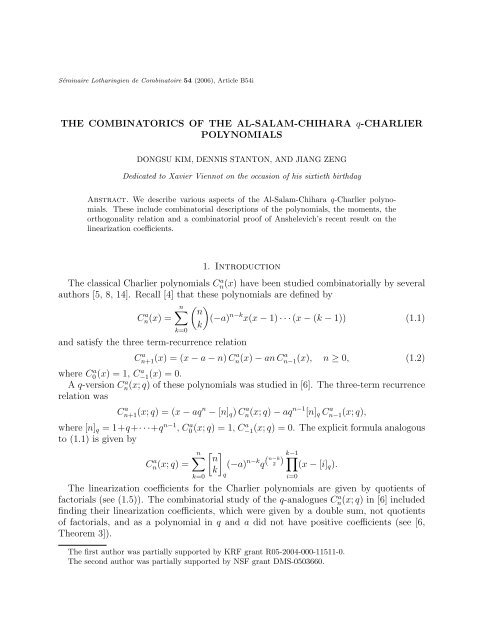
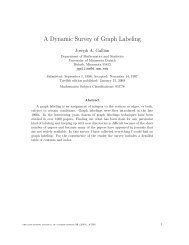

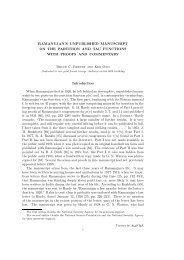
![(.,t ] and [s, .) , where [s,t ] = {s' GT; s ¤ s' ¤ t} , (.,t ] = {s' GT; s' ¤ t} and ...](https://img.yumpu.com/43303393/1/184x260/t-and-s-where-st-s-gt-s-a-s-a-t-t-s-gt-s-a-t-and-.jpg?quality=85)
